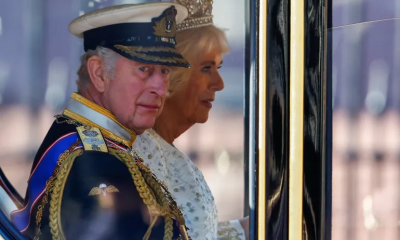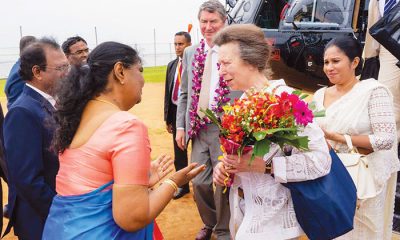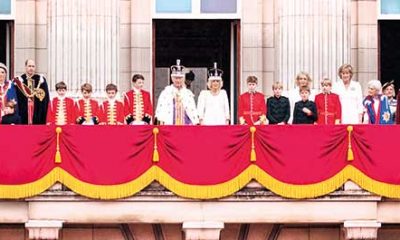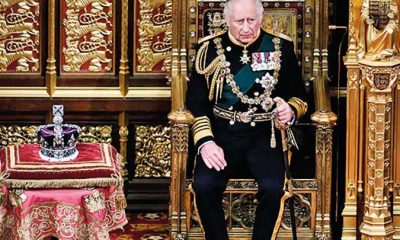Features
The Coronation: facts, comments, anecdotes
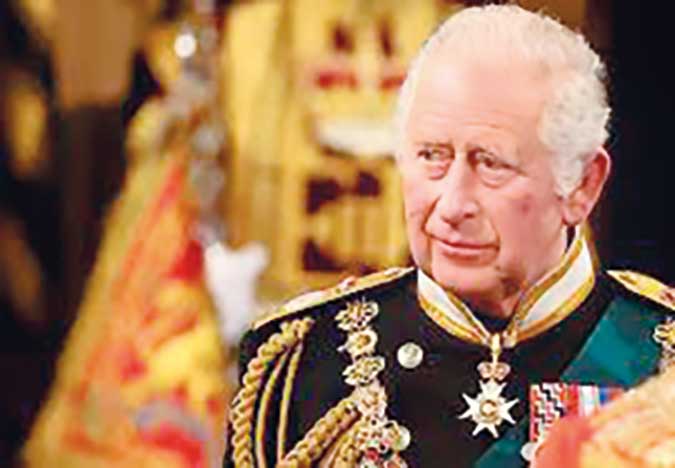
“Anointed with holy oil and enthroned on St Edward’a chair, King Charles III  was crowned on Saturday in a solemn ritual that stretches back more than a millennium, but unfolded with multiple concessions to the modern age.”
was crowned on Saturday in a solemn ritual that stretches back more than a millennium, but unfolded with multiple concessions to the modern age.”
Quoted above is the first sentence of one of the many press articles I read, this being in the New York Times of May 7. It encapsulates the main features of this momentous event, which as an Anglophile with interest in the Royal Family I watched on BBC News on May 6 from noon to late evening, and parts of the day’s events even the next. The late Queen was very much in our thoughts, particularly her coronation 70 years previous. I saw a film of it in the Regal Theatre Kandy.
Facts
The coronation service conducted by the Archbishop of Canterbury, Justin Welby, in Westminster Abbey seating 2,200 invitees, lasted almost three hours. It was very Christian and completely traditional. The most touching moments were when King Charles was divested of his regalia, outer cloak and jacket, and screened off. The Archbishop anointed him with holy oil harvested from the Mount of Olives and consecrated in the Church of the Holy Sepulcher in Jerusalem. Charles was then left to commune with his God for a short while.
King Charles’ first words after entering the church with splendorous pomp and pageantry were simple yet so significant: “I come not to be served, but to serve.” Later, in taking his oath of allegiance to Church and country, he said: “Grant that I may be a blessing to all thy children of every faith and belief.” This was his promise to be a pluralistic monarch for a diverse society. The inclusion of other religions was a must for the new king and proven when leaving the Abbey after being crowned when he detoured somewhat before he reached the exit, to acknowledge the presence of representatives of other faiths, including the London Vihara Sinhala Bhikkhu and two women in sari. The tug to the heart was when tall Prince William, heir to the throne, promised allegiance to the King and then as a son kissed his father. Camilla, now Queen and no longer Queen Consort looked composed, feminine and beautiful.
Moving with the times and more particularly in accord with King Charles’ wishes, this coronation was somewhat different from that of the Queen’s. A children’s choir was added to the choir of the Abbey. Noteworthy is it that the conductor of the Cathedral choir is Andrew Nethsinghe who played a significant role in the ceremony. To the hymns were added new compositions, one being Andrew Lloyd Weber’s ‘Make a noise’. Another innovation was having Gospel singers included; dressed in white were six black singers belting out their praises. Songs were sung in Welsh, Scottish and Irish Gaelic. Female bishops from the Church of England took part in the liturgy.
Women played important roles in the Coronation. The most significant was Penny Mordaunt in a classic green outfit with a gold embroidered pattern of fern. She is the Leader of the House of Commons who in July 2022 unsuccessfully challenged Sunak for the Conservative Party leadership. She may be PM one day. At the coronation she stood ramrod straight bearing the jewel encrusted Sword of State and took centre stage alongside Charles at different times. She led the procession of the crowned king out of the Cathedral.
An item of very great pride to us Asians, and significance, was the excellent reading of Rishi Sunak, Hindu PM of Britain, from the Epistle to the Colossians. He outdid Brit Britishers.
The one discordant noisy note was the protest against the monarchy staged small even outside London. The protesters carrying placards saying “Not my king” and shouting it out congregated mostly in Trafalgar Square. Its leader, Graham Smith, and near 100 others were arrested. They had promised not to disrupt the procession, but the police were extra cautious.
Family
“The royal family’s awkward dynamics were on display in the ceremony.” I say the awkward was mostly discourtesy of Prince Harry. He arrived from California alone, just the morning of the coronation and departed soon after the service to be at his son’s fourth birthday party. He did not appear on the balcony. Mixed with utter distaste for what he has done to dishonor his father, step-mother, brother and sister-in-law by publishing trash about them, is a sort of pity. We surmise that due to Meghan’s influence he cut himself away from his family, country and position he held and will surely rue these decisions. He was in a suit and sat in the third row next to cousins, far removed from where he should have been: next to and supportive of his brother, and suitably acknowledging his father as the crowned king
By contrast Prince William played a major role the day of the coronation and the next when he organized a concert at Windsor as tribute to the king. He and Catherine were dressed in royal regalia for the coronation service as requested by Charles but the women of even the extended family were vetoed from wearing tiaras. Hence the matching created decoration on the heads of the Duchess of Wales and daughter Charlotte. They were in matching ivory silk crepe dresses designed by Alexander McQueen. Son, Prince George, aged nine, held the robe of the king and pulled heart strings when camera-caught twisting and turning his mouth while waiting.
The speech delivered by Prince William at the end of the Windsor concert was excellent in content and delivery. He paid tribute to the king by addressing him as Pa and mentioned how much service to the nation he has already given, particularly via his Trusts and more especially the one for differently abled youth. As a very young man Prince Charles warned the environment was being damaged and the world would pay for it, if harm done was not promptly arrested.
Noteworthy it was that the king’ sister, Anne – Princess Royal – accompanied the procession riding her horse just behind the royal carriage; part of the security contingent.
Four thousand troops, including those from the Commonwealth (one soldier from the Maldives was interviewed by BBC), on horseback and foot, plus 19 bands led the royal entourage to the Abbey and back to Buckingham Palace. A fine coincidence was that the father of the Army officer –Brigade Major Lt. Col. James Shaw – who led the forces on May 6,was also an army man and led the parade at Queen Elizabeth’s coronation in 1953.
Comment
I listened to conversations that were being given on BBC’s programme on the coronation, earlier in the day. The idea was presented to a biographer of the Royal Family that Camilla is still hated as the woman who caused the death of Princess Diana and that her life-long aim of becoming queen would finally be realized. The woman answering said it was nonsense to blame Camilla and that Camilla never entertained ambitious aims. She is a shy person who does much social service with no making it known, she affirmed. The article I quote from said: “For Camilla, 75, the coronation represented the end of a decades-long rehabilitation project that began with her marriage to Charles in 2005, after the messy dissolution of his marriage to Princess Diana.” The couple are said to be very happy together and complement each other.
Anecdotes
I promised these in my title. I have space for just three.
Prince Charles, when quite young, had wanted to meet Barbara Streisand when he was visiting LA. He met her in a studio while she was recording. Finding her sipping from a mug, he asked her what it was. Tea, she replied, to keep my throat warm. What sort of tea, he enquired. Taste it, she said and offered her mug to him. He drank off it. She proclaimed she admired him affectionately from that day on.
Prince Charles came to Sri Lanka to be chief guest at the 60th Independence Celebrations February 4, 1998. The civil war was raging and he sure would have been warned but he said he was not afraid and braved it. Chandrika B K was Prez, and the parade was opposite the Parliament in Kotte. The Prince had to sit between Mrs B, PM, unable to turn her neck to speak with him, and Lt. Col. Anurudha Ratwatte, Deputy Defense Minister leaning heavily on a walking stick.
Then the IGP, standing behind the Prez as she delivered her address, fell with a resounding thud in a faint. People remarked the prince got scared and escaped. He did leave early because he wanted to visit Jaffna where he donated money to rebuild the clock tower that was war destroyed. This clock tower was built in honour of the visiting Prince of Wales – Albert Edward – in 1875. My comment here is: such rotten allocation of even seats; the prince spent his time reading the brochure distributed.
I read that local planners of the visit and others bungled but to the amusement of the Prince who had said he had to bite his lips and tongue to prevent roaring laughter. Why? The 21 gun salute set the grass at Katunayake ablaze and while the Prince was being welcomed fire engines roared past the dais. He was to visit the Dalada Maligawa but it had been LTTE damaged a week previous. Hence, instead, he was taken to inspect a factory turning out men’s underwear! Only our planners could be so idiotic!
He requested a visit to Lunuganga at short notice. Geoffrey Bawa rushed to buy finger food and be present. The prince had walked all over the grounds and leisurely had tea with Bawa. Charles’ interest in gardening and architecture is well known. Basically he is a humane man who is now King of Britain and the Commonwealth. I bet he will be excellent.
My concluding comment is that even in a country used to royal spectacle, the coronation weekend beggared all previous events, even royal weddings. The coronation itself is dated to that of King Edgar in AD 973 in the Roman city of Bath. Thus the millennium long traditions, the splendor, and precision and excellence of planning; which are uniquely British.
Features
The heart-friendly health minister

by Dr Gotabhya Ranasinghe
Senior Consultant Cardiologist
National Hospital Sri Lanka
When we sought a meeting with Hon Dr. Ramesh Pathirana, Minister of Health, he graciously cleared his busy schedule to accommodate us. Renowned for his attentive listening and deep understanding, Minister Pathirana is dedicated to advancing the health sector. His openness and transparency exemplify the qualities of an exemplary politician and minister.
Dr. Palitha Mahipala, the current Health Secretary, demonstrates both commendable enthusiasm and unwavering support. This combination of attributes makes him a highly compatible colleague for the esteemed Minister of Health.
Our discussion centered on a project that has been in the works for the past 30 years, one that no other minister had managed to advance.
Minister Pathirana, however, recognized the project’s significance and its potential to revolutionize care for heart patients.
The project involves the construction of a state-of-the-art facility at the premises of the National Hospital Colombo. The project’s location within the premises of the National Hospital underscores its importance and relevance to the healthcare infrastructure of the nation.
This facility will include a cardiology building and a tertiary care center, equipped with the latest technology to handle and treat all types of heart-related conditions and surgeries.
Securing funding was a major milestone for this initiative. Minister Pathirana successfully obtained approval for a $40 billion loan from the Asian Development Bank. With the funding in place, the foundation stone is scheduled to be laid in September this year, and construction will begin in January 2025.
This project guarantees a consistent and uninterrupted supply of stents and related medications for heart patients. As a result, patients will have timely access to essential medical supplies during their treatment and recovery. By securing these critical resources, the project aims to enhance patient outcomes, minimize treatment delays, and maintain the highest standards of cardiac care.
Upon its fruition, this monumental building will serve as a beacon of hope and healing, symbolizing the unwavering dedication to improving patient outcomes and fostering a healthier society.We anticipate a future marked by significant progress and positive outcomes in Sri Lanka’s cardiovascular treatment landscape within the foreseeable timeframe.
Features
A LOVING TRIBUTE TO JESUIT FR. ALOYSIUS PIERIS ON HIS 90th BIRTHDAY

by Fr. Emmanuel Fernando, OMI
Jesuit Fr. Aloysius Pieris (affectionately called Fr. Aloy) celebrated his 90th birthday on April 9, 2024 and I, as the editor of our Oblate Journal, THE MISSIONARY OBLATE had gone to press by that time. Immediately I decided to publish an article, appreciating the untiring selfless services he continues to offer for inter-Faith dialogue, the renewal of the Catholic Church, his concern for the poor and the suffering Sri Lankan masses and to me, the present writer.
It was in 1988, when I was appointed Director of the Oblate Scholastics at Ampitiya by the then Oblate Provincial Fr. Anselm Silva, that I came to know Fr. Aloy more closely. Knowing well his expertise in matters spiritual, theological, Indological and pastoral, and with the collaborative spirit of my companion-formators, our Oblate Scholastics were sent to Tulana, the Research and Encounter Centre, Kelaniya, of which he is the Founder-Director, for ‘exposure-programmes’ on matters spiritual, biblical, theological and pastoral. Some of these dimensions according to my view and that of my companion-formators, were not available at the National Seminary, Ampitiya.
Ever since that time, our Oblate formators/ accompaniers at the Oblate Scholasticate, Ampitiya , have continued to send our Oblate Scholastics to Tulana Centre for deepening their insights and convictions regarding matters needed to serve the people in today’s context. Fr. Aloy also had tried very enthusiastically with the Oblate team headed by Frs. Oswald Firth and Clement Waidyasekara to begin a Theologate, directed by the Religious Congregations in Sri Lanka, for the contextual formation/ accompaniment of their members. It should very well be a desired goal of the Leaders / Provincials of the Religious Congregations.
Besides being a formator/accompanier at the Oblate Scholasticate, I was entrusted also with the task of editing and publishing our Oblate journal, ‘The Missionary Oblate’. To maintain the quality of the journal I continue to depend on Fr. Aloy for his thought-provoking and stimulating articles on Biblical Spirituality, Biblical Theology and Ecclesiology. I am very grateful to him for his generous assistance. Of late, his writings on renewal of the Church, initiated by Pope St. John XX111 and continued by Pope Francis through the Synodal path, published in our Oblate journal, enable our readers to focus their attention also on the needed renewal in the Catholic Church in Sri Lanka. Fr. Aloy appreciated very much the Synodal path adopted by the Jesuit Pope Francis for the renewal of the Church, rooted very much on prayerful discernment. In my Religious and presbyteral life, Fr.Aloy continues to be my spiritual animator / guide and ongoing formator / acccompanier.
Fr. Aloysius Pieris, BA Hons (Lond), LPh (SHC, India), STL (PFT, Naples), PhD (SLU/VC), ThD (Tilburg), D.Ltt (KU), has been one of the eminent Asian theologians well recognized internationally and one who has lectured and held visiting chairs in many universities both in the West and in the East. Many members of Religious Congregations from Asian countries have benefited from his lectures and guidance in the East Asian Pastoral Institute (EAPI) in Manila, Philippines. He had been a Theologian consulted by the Federation of Asian Bishops’ Conferences for many years. During his professorship at the Gregorian University in Rome, he was called to be a member of a special group of advisers on other religions consulted by Pope Paul VI.
Fr. Aloy is the author of more than 30 books and well over 500 Research Papers. Some of his books and articles have been translated and published in several countries. Among those books, one can find the following: 1) The Genesis of an Asian Theology of Liberation (An Autobiographical Excursus on the Art of Theologising in Asia, 2) An Asian Theology of Liberation, 3) Providential Timeliness of Vatican 11 (a long-overdue halt to a scandalous millennium, 4) Give Vatican 11 a chance, 5) Leadership in the Church, 6) Relishing our faith in working for justice (Themes for study and discussion), 7) A Message meant mainly, not exclusively for Jesuits (Background information necessary for helping Francis renew the Church), 8) Lent in Lanka (Reflections and Resolutions, 9) Love meets wisdom (A Christian Experience of Buddhism, 10) Fire and Water 11) God’s Reign for God’s poor, 12) Our Unhiddden Agenda (How we Jesuits work, pray and form our men). He is also the Editor of two journals, Vagdevi, Journal of Religious Reflection and Dialogue, New Series.
Fr. Aloy has a BA in Pali and Sanskrit from the University of London and a Ph.D in Buddhist Philosophy from the University of Sri Lankan, Vidyodaya Campus. On Nov. 23, 2019, he was awarded the prestigious honorary Doctorate of Literature (D.Litt) by the Chancellor of the University of Kelaniya, the Most Venerable Welamitiyawe Dharmakirthi Sri Kusala Dhamma Thera.
Fr. Aloy continues to be a promoter of Gospel values and virtues. Justice as a constitutive dimension of love and social concern for the downtrodden masses are very much noted in his life and work. He had very much appreciated the commitment of the late Fr. Joseph (Joe) Fernando, the National Director of the Social and Economic Centre (SEDEC) for the poor.
In Sri Lanka, a few religious Congregations – the Good Shepherd Sisters, the Christian Brothers, the Marist Brothers and the Oblates – have invited him to animate their members especially during their Provincial Congresses, Chapters and International Conferences. The mainline Christian Churches also have sought his advice and followed his seminars. I, for one, regret very much, that the Sri Lankan authorities of the Catholic Church –today’s Hierarchy—- have not sought Fr.
Aloy’s expertise for the renewal of the Catholic Church in Sri Lanka and thus have not benefited from the immense store of wisdom and insight that he can offer to our local Church while the Sri Lankan bishops who governed the Catholic church in the immediate aftermath of the Second Vatican Council (Edmund Fernando OMI, Anthony de Saram, Leo Nanayakkara OSB, Frank Marcus Fernando, Paul Perera,) visited him and consulted him on many matters. Among the Tamil Bishops, Bishop Rayappu Joseph was keeping close contact with him and Bishop J. Deogupillai hosted him and his team visiting him after the horrible Black July massacre of Tamils.
Features
A fairy tale, success or debacle

Sri Lanka-Singapore Free Trade Agreement
By Gomi Senadhira
senadhiragomi@gmail.com
“You might tell fairy tales, but the progress of a country cannot be achieved through such narratives. A country cannot be developed by making false promises. The country moved backward because of the electoral promises made by political parties throughout time. We have witnessed that the ultimate result of this is the country becoming bankrupt. Unfortunately, many segments of the population have not come to realize this yet.” – President Ranil Wickremesinghe, 2024 Budget speech
Any Sri Lankan would agree with the above words of President Wickremesinghe on the false promises our politicians and officials make and the fairy tales they narrate which bankrupted this country. So, to understand this, let’s look at one such fairy tale with lots of false promises; Ranil Wickremesinghe’s greatest achievement in the area of international trade and investment promotion during the Yahapalana period, Sri Lanka-Singapore Free Trade Agreement (SLSFTA).
It is appropriate and timely to do it now as Finance Minister Wickremesinghe has just presented to parliament a bill on the National Policy on Economic Transformation which includes the establishment of an Office for International Trade and the Sri Lanka Institute of Economics and International Trade.
Was SLSFTA a “Cleverly negotiated Free Trade Agreement” as stated by the (former) Minister of Development Strategies and International Trade Malik Samarawickrama during the Parliamentary Debate on the SLSFTA in July 2018, or a colossal blunder covered up with lies, false promises, and fairy tales? After SLSFTA was signed there were a number of fairy tales published on this agreement by the Ministry of Development Strategies and International, Institute of Policy Studies, and others.
However, for this article, I would like to limit my comments to the speech by Minister Samarawickrama during the Parliamentary Debate, and the two most important areas in the agreement which were covered up with lies, fairy tales, and false promises, namely: revenue loss for Sri Lanka and Investment from Singapore. On the other important area, “Waste products dumping” I do not want to comment here as I have written extensively on the issue.
1. The revenue loss
During the Parliamentary Debate in July 2018, Minister Samarawickrama stated “…. let me reiterate that this FTA with Singapore has been very cleverly negotiated by us…. The liberalisation programme under this FTA has been carefully designed to have the least impact on domestic industry and revenue collection. We have included all revenue sensitive items in the negative list of items which will not be subject to removal of tariff. Therefore, 97.8% revenue from Customs duty is protected. Our tariff liberalisation will take place over a period of 12-15 years! In fact, the revenue earned through tariffs on goods imported from Singapore last year was Rs. 35 billion.
The revenue loss for over the next 15 years due to the FTA is only Rs. 733 million– which when annualised, on average, is just Rs. 51 million. That is just 0.14% per year! So anyone who claims the Singapore FTA causes revenue loss to the Government cannot do basic arithmetic! Mr. Speaker, in conclusion, I call on my fellow members of this House – don’t mislead the public with baseless criticism that is not grounded in facts. Don’t look at petty politics and use these issues for your own political survival.”
I was surprised to read the minister’s speech because an article published in January 2018 in “The Straits Times“, based on information released by the Singaporean Negotiators stated, “…. With the FTA, tariff savings for Singapore exports are estimated to hit $10 million annually“.
As the annual tariff savings (that is the revenue loss for Sri Lanka) calculated by the Singaporean Negotiators, Singaporean $ 10 million (Sri Lankan rupees 1,200 million in 2018) was way above the rupees’ 733 million revenue loss for 15 years estimated by the Sri Lankan negotiators, it was clear to any observer that one of the parties to the agreement had not done the basic arithmetic!
Six years later, according to a report published by “The Morning” newspaper, speaking at the Committee on Public Finance (COPF) on 7th May 2024, Mr Samarawickrama’s chief trade negotiator K.J. Weerasinghehad had admitted “…. that forecasted revenue loss for the Government of Sri Lanka through the Singapore FTA is Rs. 450 million in 2023 and Rs. 1.3 billion in 2024.”
If these numbers are correct, as tariff liberalisation under the SLSFTA has just started, we will pass Rs 2 billion very soon. Then, the question is how Sri Lanka’s trade negotiators made such a colossal blunder. Didn’t they do their basic arithmetic? If they didn’t know how to do basic arithmetic they should have at least done their basic readings. For example, the headline of the article published in The Straits Times in January 2018 was “Singapore, Sri Lanka sign FTA, annual savings of $10m expected”.
Anyway, as Sri Lanka’s chief negotiator reiterated at the COPF meeting that “…. since 99% of the tariffs in Singapore have zero rates of duty, Sri Lanka has agreed on 80% tariff liberalisation over a period of 15 years while expecting Singapore investments to address the imbalance in trade,” let’s turn towards investment.
Investment from Singapore
In July 2018, speaking during the Parliamentary Debate on the FTA this is what Minister Malik Samarawickrama stated on investment from Singapore, “Already, thanks to this FTA, in just the past two-and-a-half months since the agreement came into effect we have received a proposal from Singapore for investment amounting to $ 14.8 billion in an oil refinery for export of petroleum products. In addition, we have proposals for a steel manufacturing plant for exports ($ 1 billion investment), flour milling plant ($ 50 million), sugar refinery ($ 200 million). This adds up to more than $ 16.05 billion in the pipeline on these projects alone.
And all of these projects will create thousands of more jobs for our people. In principle approval has already been granted by the BOI and the investors are awaiting the release of land the environmental approvals to commence the project.
I request the Opposition and those with vested interests to change their narrow-minded thinking and join us to develop our country. We must always look at what is best for the whole community, not just the few who may oppose. We owe it to our people to courageously take decisions that will change their lives for the better.”
According to the media report I quoted earlier, speaking at the Committee on Public Finance (COPF) Chief Negotiator Weerasinghe has admitted that Sri Lanka was not happy with overall Singapore investments that have come in the past few years in return for the trade liberalisation under the Singapore-Sri Lanka Free Trade Agreement. He has added that between 2021 and 2023 the total investment from Singapore had been around $162 million!
What happened to those projects worth $16 billion negotiated, thanks to the SLSFTA, in just the two-and-a-half months after the agreement came into effect and approved by the BOI? I do not know about the steel manufacturing plant for exports ($ 1 billion investment), flour milling plant ($ 50 million) and sugar refinery ($ 200 million).
However, story of the multibillion-dollar investment in the Petroleum Refinery unfolded in a manner that would qualify it as the best fairy tale with false promises presented by our politicians and the officials, prior to 2019 elections.
Though many Sri Lankans got to know, through the media which repeatedly highlighted a plethora of issues surrounding the project and the questionable credentials of the Singaporean investor, the construction work on the Mirrijiwela Oil Refinery along with the cement factory began on the24th of March 2019 with a bang and Minister Ranil Wickremesinghe and his ministers along with the foreign and local dignitaries laid the foundation stones.
That was few months before the 2019 Presidential elections. Inaugurating the construction work Prime Minister Ranil Wickremesinghe said the projects will create thousands of job opportunities in the area and surrounding districts.
The oil refinery, which was to be built over 200 acres of land, with the capacity to refine 200,000 barrels of crude oil per day, was to generate US$7 billion of exports and create 1,500 direct and 3,000 indirect jobs. The construction of the refinery was to be completed in 44 months. Four years later, in August 2023 the Cabinet of Ministers approved the proposal presented by President Ranil Wickremesinghe to cancel the agreement with the investors of the refinery as the project has not been implemented! Can they explain to the country how much money was wasted to produce that fairy tale?
It is obvious that the President, ministers, and officials had made huge blunders and had deliberately misled the public and the parliament on the revenue loss and potential investment from SLSFTA with fairy tales and false promises.
As the president himself said, a country cannot be developed by making false promises or with fairy tales and these false promises and fairy tales had bankrupted the country. “Unfortunately, many segments of the population have not come to realize this yet”.
(The writer, a specialist and an activist on trade and development issues . )


